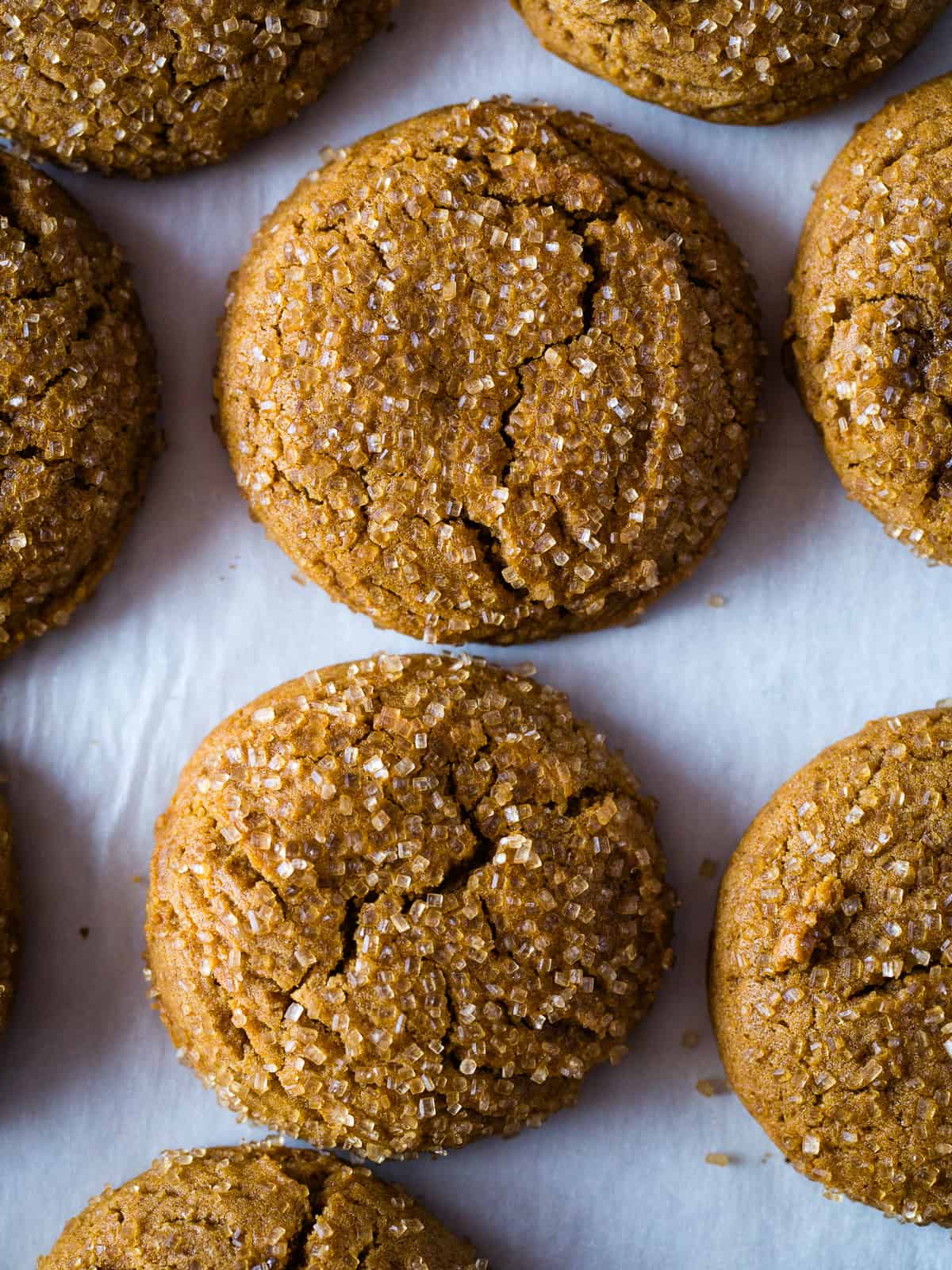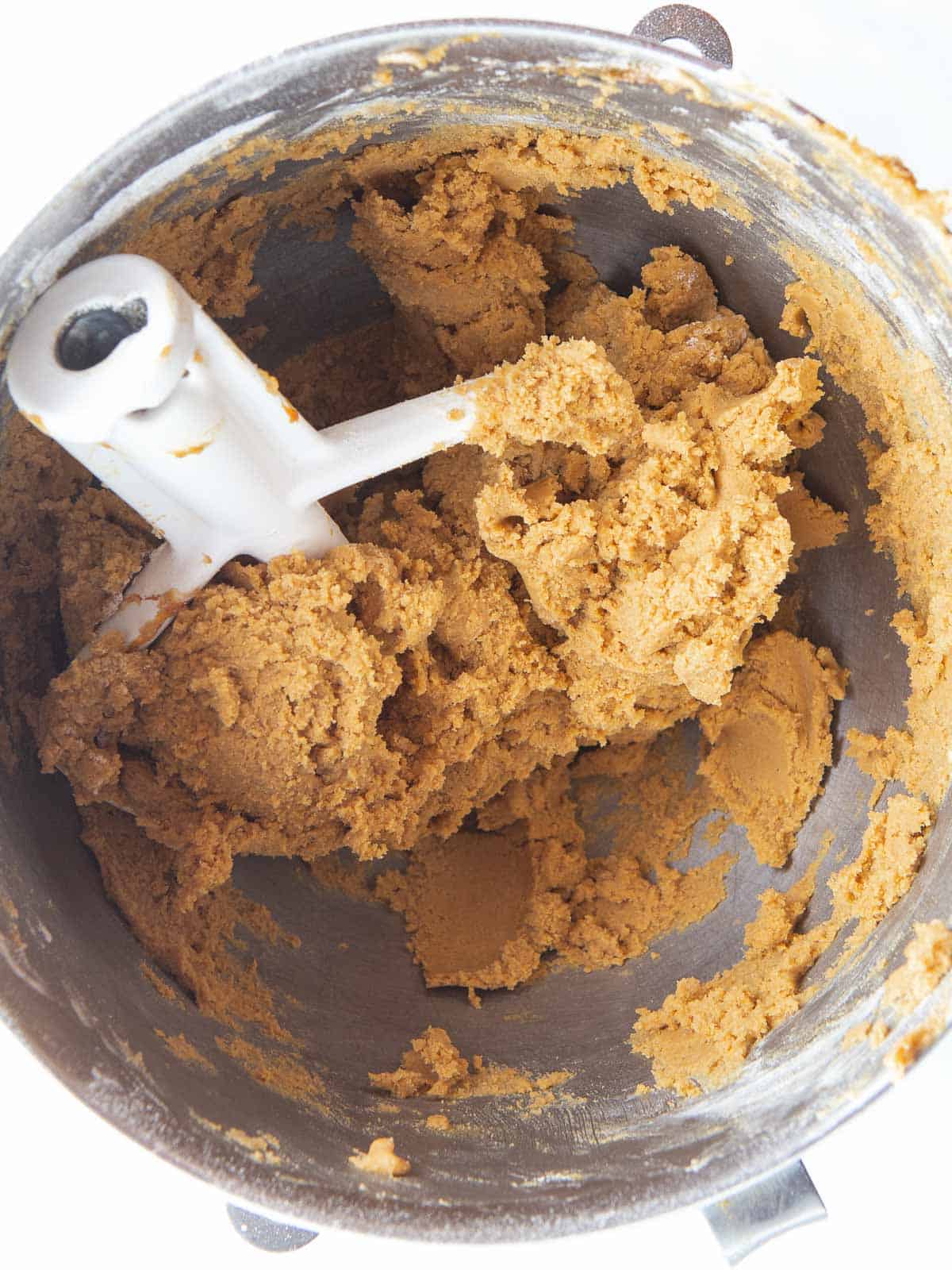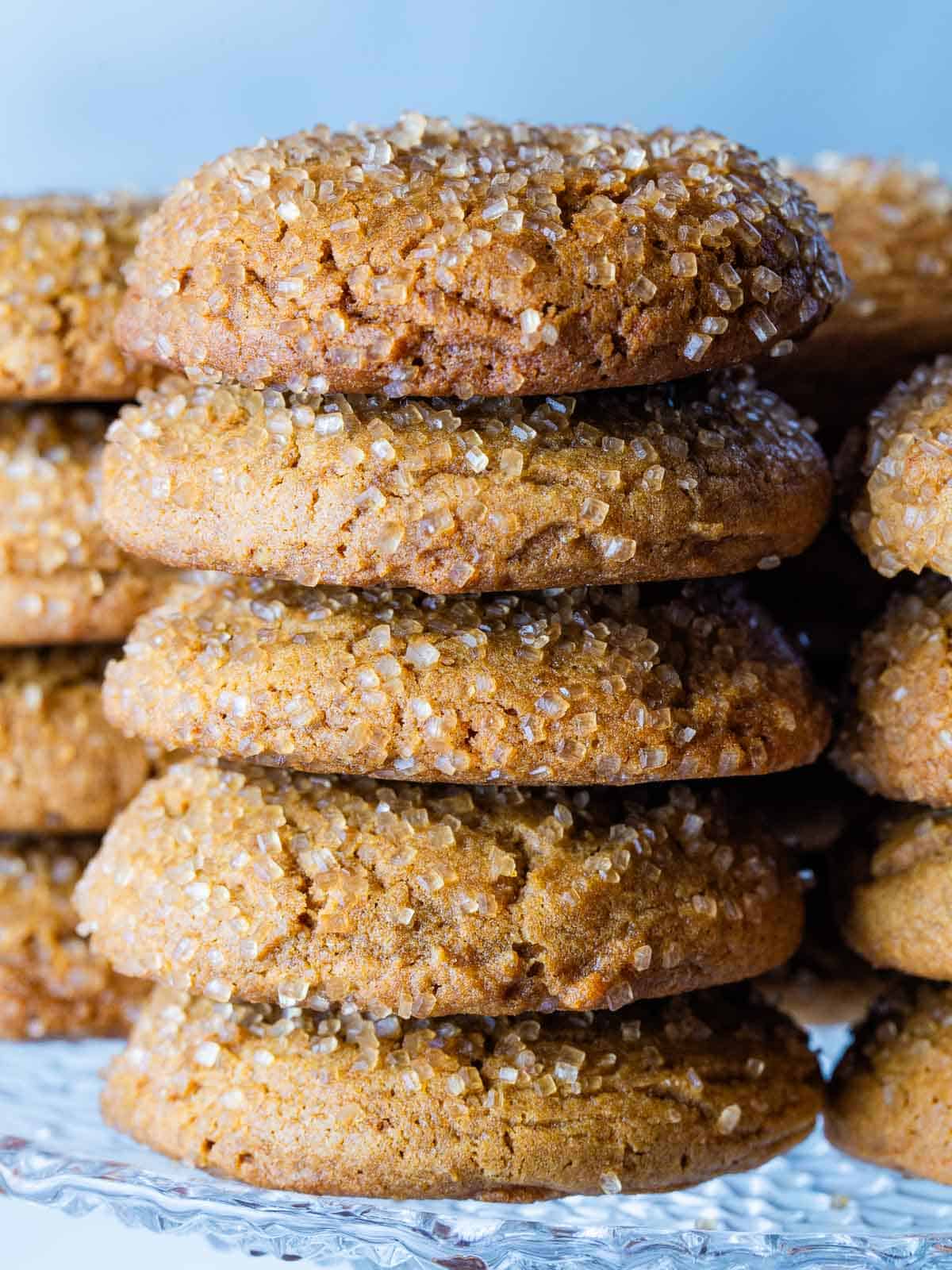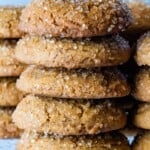This easy recipe makes gluten-free molasses cookies that are soft and spicy. They’re perfect for Christmas—they taste like soft gingerbread cookies. To make a batch, make the dough, chill for an hour and then bake the cookies. The sugar coating is optional but adds a fabulous crunch. (dairy-free variation included with the recipe!)

What are gluten-free molasses cookies?
Think of molasses cookies as soft gingerbread cookies. They’re soft and spicy with a lovely crunchy sugar coating. They taste like molasses and baking spices. The ginger and cinnamon make them a perfect Christmas cookie.
While the flavor is similar to gluten-free gingerbread cookies, these are a drop-style cookie. So they’re faster to make because there’s no rolling or cookie cutters required. The ingredients include gluten-free flour, butter, brown sugar, and molasses. Along with a perfect blend of spices and vanilla.
Ingredients.
Let’s take a look at the ingredients you need to make this recipe. As with all gluten-free recipes, these cookies were developed using the following ingredients. Using different ingredients or substitutions can cause the recipe to fail.
- Gluten-free all-purpose flour. A gluten-free flour blend with xanthan gum works helps the cookies hold their shape. If your blend doesn’t include xanthan, whisk a half teaspoon into your gluten-free flour before using.
- Butter. Use softened butter. Dairy-free butter works great in this cookie recipe.
- Brown sugar. For the best flavor, use dark brown sugar. It contains more molasses than light brown sugar.
- Molasses. Be sure to use unsulphured or light molasses. (Grandma’s molasses is the brand I use.) Do not use blackstrap molasses in this recipe.
- Egg. One large egg helps the dough come together.
- Spices. A generous amount of ginger and cinnamon add the spicy flavor. Use whatever baking spices you love.
How to Make Gluten-Free Molasses Cookies.
I love this recipe because it’s so easy to make! You simply mix the dough. Let it chill for a couple hours and then roll into balls. The most important step? Scraping the bowl as you make the dough. We want every bit of molasses in the cookies.

Make the dough.
First whisk together the dry ingredients in a medium bowl. We want all the spices mixed evenly throughout the gluten-free flour. The helps every cookie taste nice and spicy.
Then mix together the soft butter and brown sugar. Mix it together until it looks like a very thick paste.
Add the egg and molasses and mix until it’s light. At this point, stop the mixer and scrape down the bowl. Once you do that, mix everything for another 30 seconds or so.
Stop the mixer and add the gluten-free flour mixture. Mix everything together until a thick dough forms.
Chill.
Cover the dough and chill it for at least an hour. This helps the gluten-free absorb the liquid. So they’re soft and not gritty.
Scoop.
Scoop the dough into balls. I like to use a cookie scoop for this step. You want to use about a tablespoon of cookie dough for each cookie.
Roll each cookie in sugar. This step is totally optional but adds a really nice crunch.
Bake.
Place the cookies on a parchment-lined baking sheet and bake until the edges are set. A pan takes about 12 minutes to bake.
Transfer the cookies to a wire rack to cool completely.

Storing and Freezing.
Store the cooled cookies in an airtight container. These keep for up to five days.
These cookies freeze beautifully. Place them into a freezer container. I like to separate the layers with parchment paper so they don’t stick. Freeze the cookies for up to three months.

Soft Gluten-Free Molasses Cookies
Easy gluten-free molasses cookies. Soft and spicy. Perfect for Thanksgiving and Christmas. (Or anytime!)
Ingredients
- 2 ¼ cups gluten-free all-purpose flour, see note (11 ¼ ounces; 318 grams)
- 2 teaspoons baking soda
- 1 ½ teaspoons ground ginger
- 1 teaspoon ground cinnamon
- ½ teaspoon salt
- 12 tablespoons butter, softened (6 ounces; 170 grams)
- ¾ cup packed dark brown sugar (5 ½ ounces; 155 grams)
- ¼ cup unsulfured molasses (3 ounces; 85 grams)
- 1 large egg
- ½ cup coarse sugar or turbinado (4 ounces; 113 grams)
Instructions
-
Whisk together gluten-free flour, baking soda, ginger, cinnamon, and salt in a medium bowl. Set aside.
-
Mix together the butter and brown sugar in a large bowl until it's thick and creamy. Add the molasses and egg and mix until light, about one minute. Stop the mixer and scrape down the bottom and sides of the bowl.
Add the gluten-free flour mixture. Mix on medium speed until a thick dough forms.
-
Cover the bowl and chill for one hour or overnight.
-
Preheat oven to 350°F. Line a baking sheet with parchment paper.
-
Roll the dough into balls, about one tablespoon each. Roll dough into coarse sugar, if desired. Place dough balls on the prepared baking sheet, about 2 inches apart.
-
Bake until the cookies are set and slightly cracked, about 12-15 minutes.
-
Remove pan from the oven and let cookies cool on the pan for 4 to 5 minutes. Transfer cookies to a wire rack and cool completely.
-
Store cooled in a sealed container for up to 5 days. Or freeze for up to 3 months.
Recipe Notes
Ingredient Note
Gluten-Free Flour. This recipe was tested with Bob’s Red Mill 1:1 Gluten-Free Flour Blend. Using a different blend might change the texture of the cookies. If you’re using a blend that does not contain xanthan gum, whisk a half teaspoon into the flour before using.
Molasses. Use unsulphured or dark molasses. Blackstrap molasses are too strong for these cookies.


charlene says
can i use gluten free all purpose baking mix instead of gluten free flour
Elizabeth says
It’s hard for me to say without knowing the brand or the ingredients.
Heather says
My mom is known around our community as the “cookie lady.” But I can’t eat her cookies (not GF) and I soooo miss her sugar and molasses cookies. I just found your site and I can’t wait to make both this weekend. New subscriber, and I’ll be checking out all your other recipes. Thank you very much.
Sarah says
Wow, I often try recipes with an approach of “it is worth a try!” And you never know what you’ll get. With GF baking, my success rate is pretty low. But these cookies are awesome! I appreciate all of the tips and commentary along the way. Thank you so much for this great recipe!
Cheryl says
The cookies turned out so great! Soft and chewy. My family loved them and they’re not even on a gluten free diet
Celia says
Is it possible to make these with honey or maple syrup instead of brown sugar?
Elizabeth says
I don’t think so. Replacing the brown sugar with a liquid sugar, in addition to the molasses, will cause the cookies to spread too much.
Leontine Hartzell says
these cookies were so dry and didn’t spread much at all, such a disappointment!
Elizabeth says
Oh! I’m so sorry to hear this. Can you say more about what flour you used?
With the brown sugar, molasses, and 12 tablespoons of butter, they should not have been dry. I’d love to get to the bottom of this!
Jess Gralak says
These were so good!!! Better than the kind I found at the grocery store! The only thing I did differently was add a 1/4 tsp of cloves because I ran out of cinnamon. Next time I am going to try the course granulated sugar. Thank you for this recipe!!!
Cooper Young says
I just tried this recipe for the first time the other day and I am very happy with the results. Being Celiac, I have wrestled with finding good gluten free recipes my whole life and I’m certain I will be using this one for the rest of my life. Delicious! and perfect on the first try. I must ask, might there be a good chocolate adaptation to this recipe? How could I off set the dryness if I were to add coco powder?
Lori B. says
I made these today. Used same weight of America’s Test Kitchen flour blend and 3/8 tsp xanthan gum. I got 38 flat cookies that taste delicious, but are very thin. I refrigerated the dough for 3 hours, then put back in fridge before loading each pan. My butter was from ALDI, I’ve heard that they have a greater proportion of water than some more expensive brands. I’m leaning to using half solid shortening, half butter. I cooked each pan 10-11 minutes, would have been incinerated in 15 minutes. Luckily, I set the first timer for 12 minutes (I always check early with a new recipe, just in case) and checked after 9 minutes because I could really smell them.
Lori B. says
I forgot to post my recipe rating. It would be nice if all the larger quantities were also given in metric, I’m a scientist and prefer the accuracy.
Greer says
I used Walmart’s Great Value Gluten Free All-purpose Flour, & the consistency of these cookies was perfect! I did refrigerate the dough overnight. Your description of these being a molasses cookie vs a gingerbread spice cookie was well taken; I will definitely make these again & just adjust the spices to my liking. Thanks for a great recipe I can serve even to a non gluten-free crowd!
Momma of Many says
I made these without the refrigerator time and they turned out wonderfully. I also added 1/4 tsp cloves and baked for 13-14 minutes.
Holly says
These cookies were soft and perfect, best GF cookies I’ve made yet. Thank you for the great recipe!